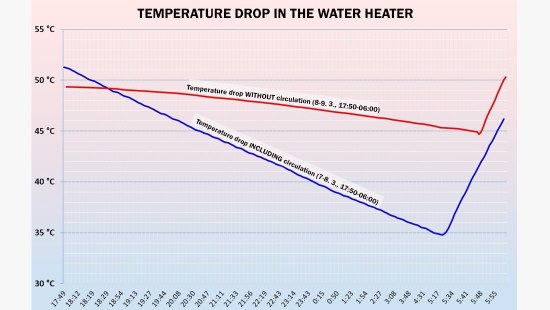Practical experience from the pilot installation in Omice

The first of these is to provide comfort – water of the required temperature is immediately available from the outlet fixture. This automatically results in the fulfilment of the second function – the saving of water. This is because water is not wasted, which it is when a consumer turns on an outlet fixture and has to wait for water of the required temperature to get to it from a tank. Especially in the case of larger family homes, the amount saved can be significant when it is calculated for the whole year.
The comfort and water saving mentioned above is not "free", however. The warm water is made to circulate in the circulation pipe by a small pump with a wattage of approximately 5 W, and additionally the circulation of water in the distribution system also causes undesired cooling of the water in the tank. These are losses that are generally accepted for the sake of comfort, and in practice, probably no one is able to quantify them accurately. Nevertheless, the pilot project at the family home in Omice, thanks to the detailed monitoring of all energy flows, makes it possible to focus on such details as the effect of warm water circulation on the total energy consumption in the building.
At the beginning, two boundary states were tested – first, the circulation was operated permanently, without any form of control, and then it was switched off completely. The test was performed on two consecutive days, from 6 p.m. to 6 a.m. in both cases. During this time, hot water consumption was also completely interrupted. The water temperature was recorded in the top part of the tank.
Of course, the warm water in the heater also cools down by itself via heat losses through the tank walls, which is shown in the graph above by the red curve. Without any consumption and without the operation of the circulation system, the water temperature dropped from 49°C to 45°C in 12 hours.
The blue curve shows the change in the water temperature in the heater when the circulation pump was switched on. The graph shows that the decrease in water temperature in the tank was 4 times higher (!) due to the circulation taking place during the same period – the water temperature dropped from 51°C to 35°C after 12 hours. If we subtract the spontaneous cooling of the tank, then the circulation itself caused a drop in temperature of 12°C in 12 hours. The tank contains 200 L of water, so this loss represents 3.8 kWh of energy (including the consumption of the circulation pump). It can be deduced simply from this information that the operation of the circulation system means a loss of about 0.32 kW.
At the moment, this is only the first part of the measurements, because the boundary states do not correspond to real operating conditions. Warm water circulation systems are never operated 24 hours a day – they are standardly controlled according to a time programme. However, daily operation is never completely regular, and therefore it is customary to set a timetable with a relatively large variance. A completely new arrangement will be used in the family home in Omice – special cameras with a very low resolution which monitor and react to the presence of people in the individual parts of the house. As soon as the presence of a person is detected in the vicinity of one of the outlet taps, the circulation pump will be switched on immediately with a minimum time overlap. At the same time, a minimum interval will be set between two circulation pump start-ups so that the pump isn´t constantly in operation when people are permanently present. This should ensure maximum effectiveness while providing the required comfort, and also minimize energy losses.


